Discover the Enchantment of Ngoc Son Temple in Hanoi
Tucked on Hoan Kiem Lake, Ngoc Son Temple is a peaceful haven amid the busy city of Hanoi. Strenched in history and culture, this famous shrine provides guests with a window into Vietnam’s rich legacy. This MOTOGO Tours article will enable you to investigate the rich history, architectural beauty, and cultural value of Ngoc Son Temple.
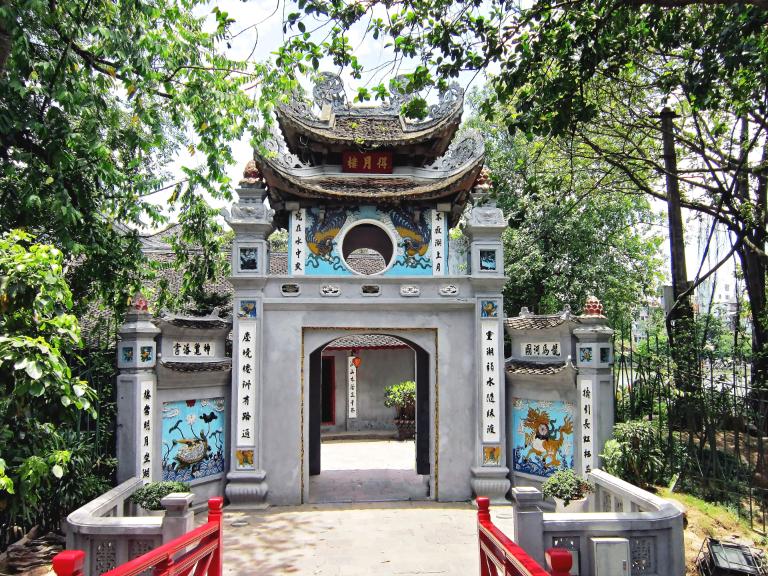
Historical Background of Ngoc Son Temple
Built in the 18th century, the temple has been a cultural emblem expressing the soul of Vietnam as well as a place of worship. Its past attests to the city’s resiliency, spirituality, and people’s continuing vitality.
Founding of the Temple
Ngoc Son Temple has historical as well as legendary roots. The shrine is thought to have been first constructed in respect of Tran Hung Dao, one of Vietnam’s most renowned national heroes. Renowned for his strategic acumen in thwarting three Mongol invasions, 13th-century military commander Tran Hung Dao was His military might and unflinching patriotism have solidified his reputation as a symbol of national pride and resistance.
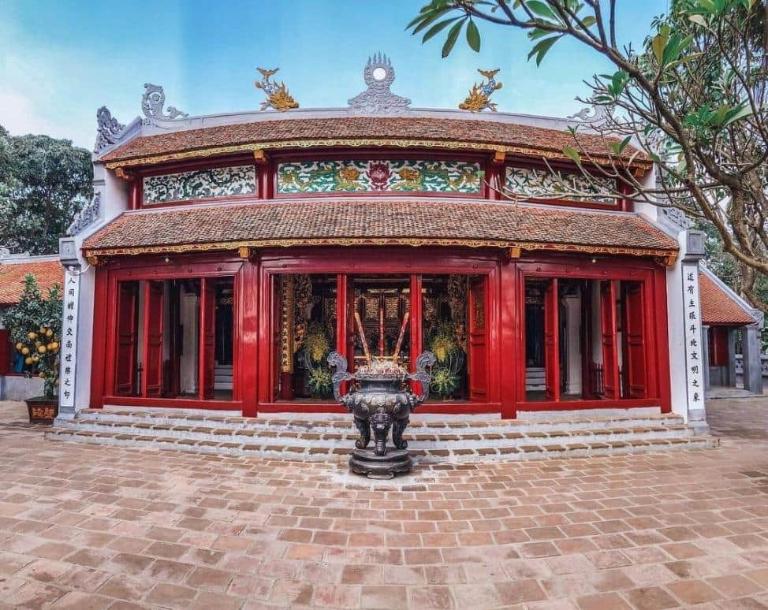
Originally a little pagoda honoring Buddhism, the site was converted over time into a temple to honor Tran Hung Dao and other respected leaders. The temple’s connection to the general not only emphasizes its historical relevance but also reflects the great reverence Vietnamese people feel for those who have protected their country. The temple changed to incorporate other gods, therefore merging the boundaries between history and mythology.
Key Historical Events
Ngoc Son Temple has silently observed some of the most significant events in Vietnamese history over its lifetime. Under the direction of scholar Nguyen Van Sieu, the temple received major repairs in the 19th century adding the famous Pen Tower (Thap But) and the Ink Slab (Dai Nghien).
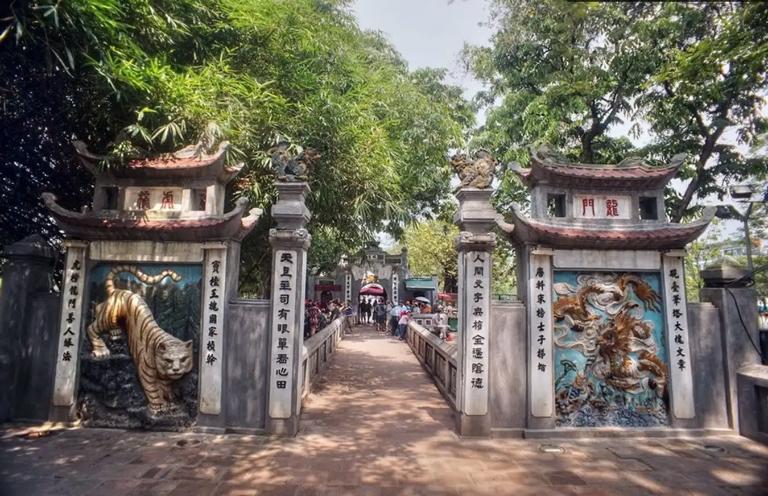
Rising boldly at the entryway, the Pen Tower bears the inscription “Writing on the clear blue sky,” so signifying the quest of academic achievement. Meanwhile, the Ink Slab reminds us of the need of moral integrity and education, values long loved in Vietnamese society.
Ngoc Son Temple grew to represent national pride and cultural preservation throughout the French colonial era. The temple stayed a pillar of Vietnamese tradition in face of foreign rule’s effects and demands. It was a haven for people looking for inspiration and comfort amid trying circumstances as well as a place of worship.
>>> Explore: History of Hanoi: A Journey Through Vietnam’s Capital
Architectural Features of Ngoc Son Temple
Standing as an architectural wonder, Ngoc Son Temple reflects a harmonic fusion of Vietnamese culture, spiritual symbolism, and environment. Delicate carvings, vivid colors, and a painstaking plan that links the physical structure with its peaceful surroundings define its design, which is a magnificent portrayal of traditional Vietnamese architecture.
Design and Layout
Accessible by The Huc Bridge, a beautiful scarlet-painted wooden bridge that elegantly arches over the water, the temple is positioned deliberately on a little island in the midst of Hoan Kiem Lake. Translating as “Morning Sunlight Bridge”, this famous bridge represents the daily path of the sun, a concept that fits rather nicely with the spiritual core of the temple. Strolling across this bridge transports one to another era, enveloped by the soft lap of the lake.
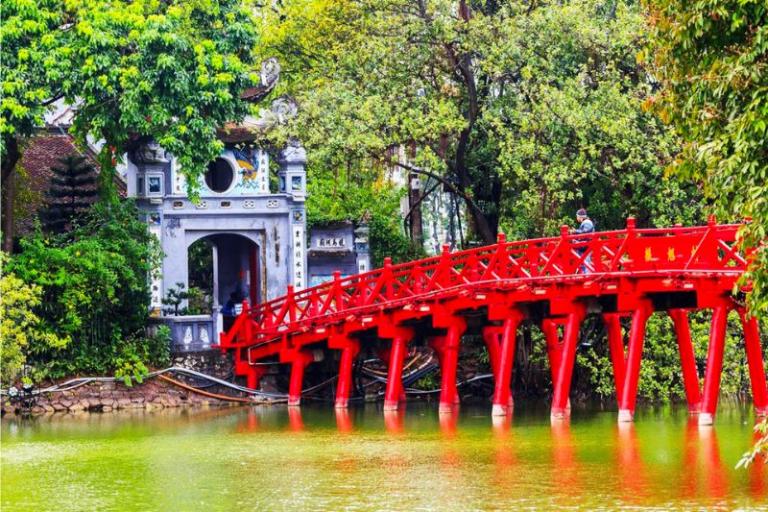
You find beautiful gardens and complex stone paths leading guests towards the main hall as soon as you arrive on temple premises. The remarkable Pen Tower (Thap But), which rises like a silent temple guardian, defines the entry. Designed like a classic scholar’s pen, this unusual form represents the search of knowledge and wisdom, therefore giving the temple grounds intellectual relevance.
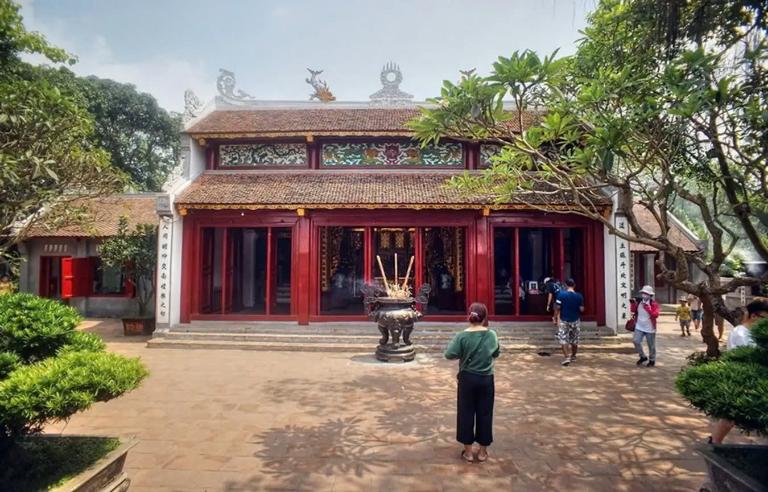
The principal temple construction is an amazing fusion of symbolic and conventional architectural features. Emphasizing balance and symmetry, its architectural form reflects the layout common of many Vietnamese temples. Often featuring dragon designs thought to ward against evil spirits, the roof is fashioned with sweeping, upward curves. Important emblems in Vietnamese society, dragons give the construction a legendary touch while reflecting strength, power, and protection.
Materials Used
Using classic elements like stone, wood, and ceramic tiles accentuates the temple’s historical authenticity. Carefully carved with minute details, the oak beams within the main hall highlight centuries-old traditional workmanship. Often including lucky symbols like lotuses, dragons, and cranes—which have great spiritual importance.
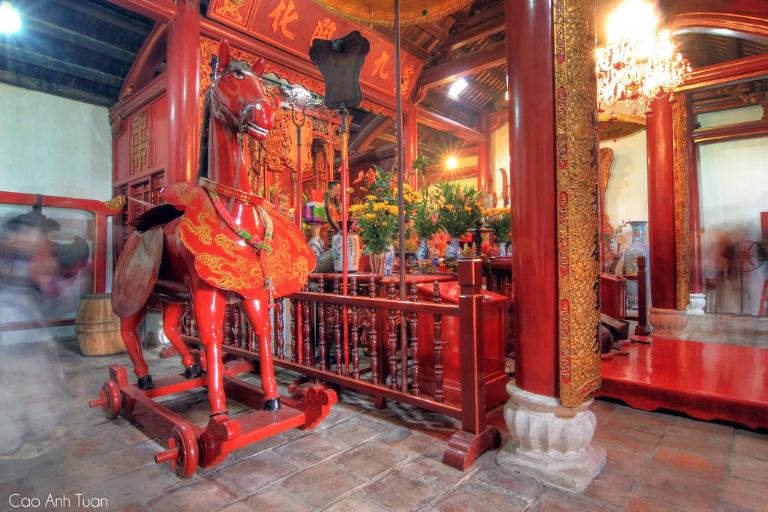
Often painted in a startling crimson, the temple’s walls represent luck and prosperity in Vietnamese tradition. Gold accents combined with this brilliant color produce a lively but respectful environment that enthralls guests. The temple’s grandeur is enhanced by the complementary crimson color of the pillars and golden accents.
Cultural Influences
Particularly from Confucianism, Taoism, and Buddhism, Ngoc Son Temple’s architecture is a lovely synthesis of many cultural inspirations. Reflecting the varied spiritual terrain of Vietnam, the temple complex has aspects honoring every one of these philosophies.
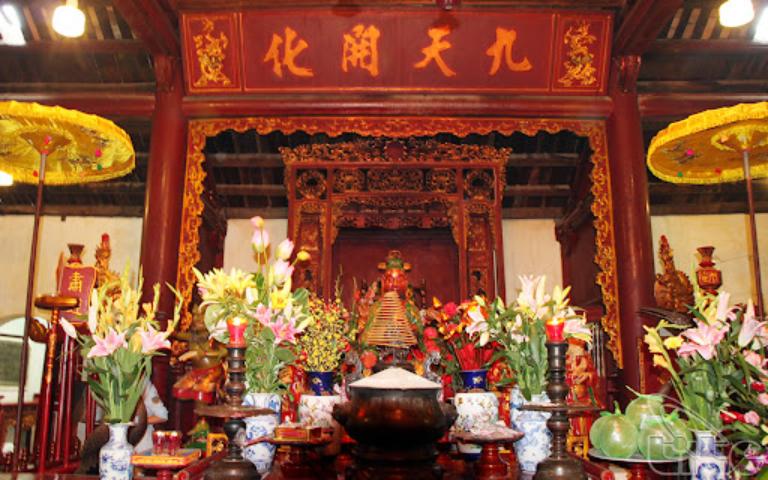
The altar area, which is richly ornamented with sculptures, bowls, and incense burners, so forming a rich tapestry of spiritual imagery, is one of the most remarkable aspects. Many times composed of bronze, these relics provide the worship area a sense of permanency and sturdiness. The well-crafted and precisely placed statues act as focal points of devotion, enabling guests to really engage with the spiritual core of the temple.

Apart from sections set for ceremonies and offerings, the temple grounds comprise smaller buildings and pavilions with various uses, from calm places for meditation. These areas are placed deliberately to provide a flow that leads guests on a spiritual trip, therefore supporting the temple’s function as a hallowed site of prayer and meditation.
>>> Explore: TOP 14 Historical Landmarks in Hanoi to Visit on a Motorbike Tour
Visiting Ngoc Son Temple
Having a taste of its past and importance now, let’s discuss visiting this famous site. Making intelligent travel plans will improve your experience and increase the memories value.
Location and Accessibility
Ngoc Son Temple, being in the center of Hanoi, is readily reachable by foot or public transit. Its close proximity to other sites such Old Quarter, Turtle Tower, and Hoan Kiem Lake qualifies it as ideal stop on your travel plans. The temple provides a peaceful haven from the bustle of the city just a little stroll from the busy streets.
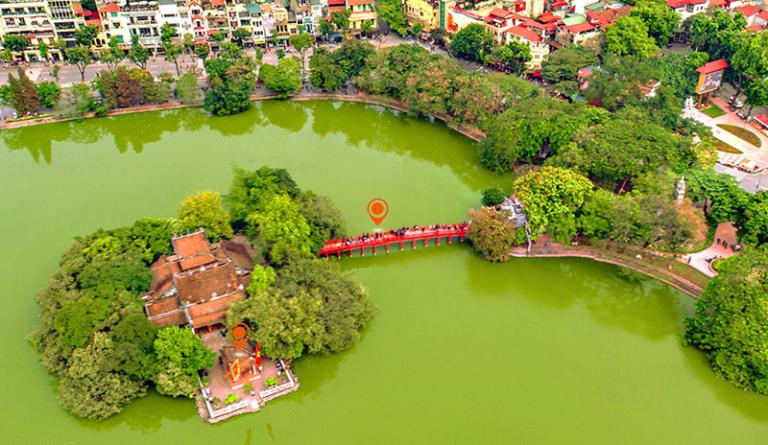
Best Times to Visit Ngoc Son Temple
Although the temple is open all year round, going early in morning or late afternoon will provide a more serene environment. Photographers would find the temple perfect for their work since the mellow light during these times accentuates its splendor. If fortune favors you, you might even catch a sight of the neighborhood going about their regular business.
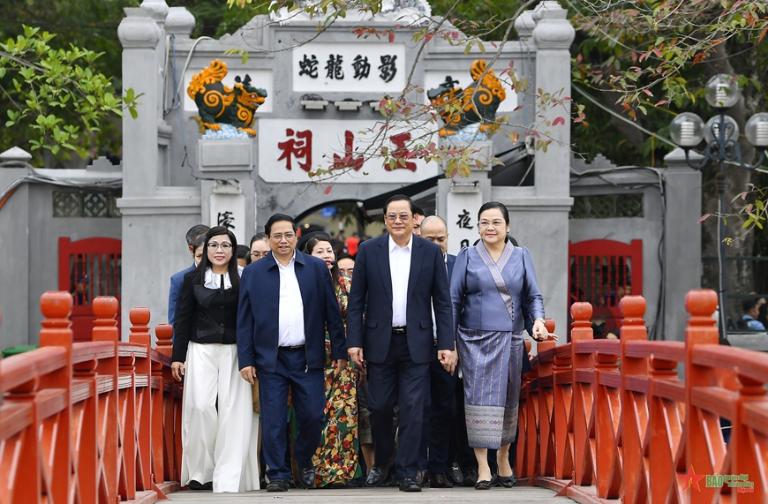
What to Expect During Your Visit
Enter the temple and you should be met with a calm environment. A multi-sensory experience results from the scent of incense, the sound of chanting, and the sight of beautiful offerings. Spend some time investigating every place so that the temple’s soul might surround you. It’s about experiencing the core of the location, not only about sight.
In addition, to enhance your experience, you can choose guided tours like Hanoi Motorbike Tours. They will provide a comprehensive overview of Ngoc Son Temple’s history and significance.
Tips for Tourists
These useful advice can help you to maximize your trip. Honor the local customs and pay close attention to your surrounds. The temple is a place of worship, hence one should keep a polite attitude.
- Dress Code and Etiquette: Visitors of Ngoc Son Temple must dress modestly. This reflects regard for the place’s holiness. Given you might have to walk on uneven paths, comfortable shoes are also advised. To honor their privacy, always ask before photographing the worshippers or during ceremonies.
- Photography Guidelines: Respectfully capture the temple’s splendor, yet keep in mind. Steer clear of flash at ceremonies and be thoughtful of those around you. The vivid hues and minute features of the temple offer many chances for breathtaking images that would most definitely make your friends jealous!
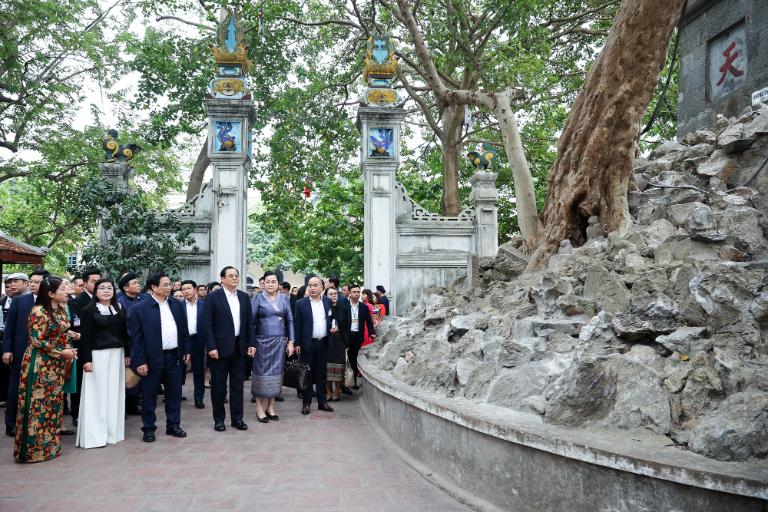
Ngoc Son Temple is a living monument to Hanoi’s cultural and spiritual legacy rather than only a historical site. Visiting here invites one to delve into the depths of Vietnamese spirituality and history. This temple invites you whether your interests are in history, spirituality, or simply a peaceful getaway.
Related Posts:
- Thang Long Imperial Citadel: Explore Vietnam’s Timeless Heritage
- Ho Chi Minh Mausoleum: A Comprehensive Guide to Vietnam’s Iconic Landmark
- St. Joseph’s Cathedral: Hanoi’s Gothic Masterpiece and Cultural Icon
- Temple of Literature | A Timeless Tribute to Vietnamese Education
- The One Pillar Pagoda: Discover Vietnam’s Cultural Jewel









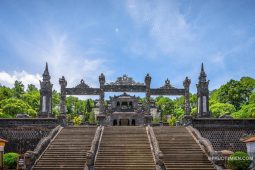
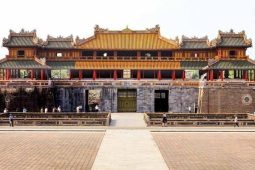

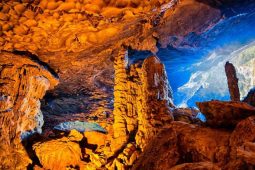
Be the first to comment!